Survivalists are always thinking ahead. We have imagined every end-of-the-world scenario and prepared our lives around them. Sure, we are safe and sound on our homestead, but what happens if we were forced to abandon our land and move on? Where would you find supplies?
For those of us who think ahead, you can create an underground cache near or far from your home. This means you have a supply option outside of your home base in case of emergencies. You must be sure only you can access the underground supply and that the gear is in a water/temperature/biodegradable-proof container.
Here are 8 items to never store underground. Before that, let’s visit how to store supplies underground in the first place. The earth is an unforgivable place, especially deep within the soil.
Related: Bury An Egg In Your Garden Soil, What Happens Few Days Later Will Surprise You
Underground Storage
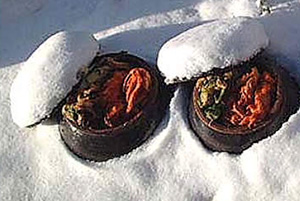
Throughout most of human history, we have taken to burying our goods for many reasons.
The earth acts as a natural safe, allowing for the burial of almost anything. It makes your items difficult to find for others. Only you will know where your storage is buried.
What you want to avoid is burying in an obvious location. Nothing is worse than looters finding your precious items only to haul it all in their truck and leave you on empty. Planning to use markers? Don’t make it obvious. Planning to make a map to your treasure? Don’t lose it!
The ground naturally decomposes whatever is buried in it. For the longest-lasting cache, your locked container will need to be mold-proof, waterproof, temperature resistant, and able to withstand pressure changes in the soil.
What To NEVER Store Underground
1. Immediate Items
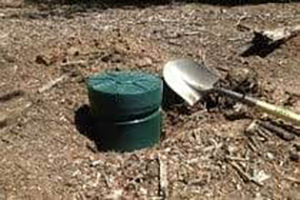 Any items that you may need within weeks or months should be kept out of your underground cache.
Any items that you may need within weeks or months should be kept out of your underground cache.
The first thing you want to avoid is having to dig up your underground storage soon after burial. Be prepared to not see these underground items for a long time.
The point of underground storage is to save the items for an emergency. The cache should only be accessed in a desperate situation. All items will likely sit there for a few years or longer before use.
2. Opened Food
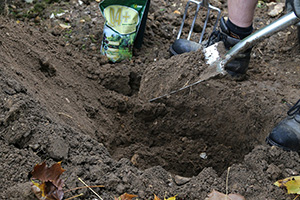
Many of us open nonperishable foods only to reseal them in vacuum or mylar bags. Rice, grains, and pasta are often stored this way. While this works for at-home food storage, this does not work for underground long-term storage. Any foods that are opened from the factory seal are at risk for critters.
Remember that this food storage is being buried in the dirt. Animals can smell food for miles. Once they have locked their noses onto your open beef jerky, the animals will stop at nothing to get ahold of it.
Even if the food is sealed inside ammo cans, a rodent will happily make its way home with your still-sealed ammo can of food.
3. “Loose” Items
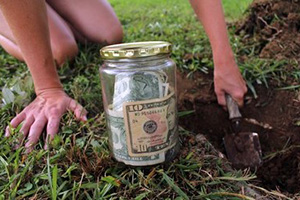 You don’t want cans or glass jars/bottles banging around when you’re burying your underground cache. Loose items can knock into one another and break, rendering your efforts useless. Wrap glass or breakable sealed containers in cloth, t-shirts, socks, or anything that will pack the cache.
You don’t want cans or glass jars/bottles banging around when you’re burying your underground cache. Loose items can knock into one another and break, rendering your efforts useless. Wrap glass or breakable sealed containers in cloth, t-shirts, socks, or anything that will pack the cache.
Broken glass can result in moisture from the contents of the jar, leading to rot and critters taking over. Shards of glass can also shred protective bags when moving your cache to bury. Be sure the container is packed tightly and efficiently.
4. Moisture-Absorbing Items
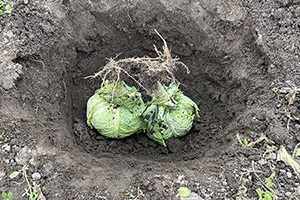
The earth’s soil is a very wet place. During rainy seasons, your areas may see multiple inches of rain just within a few hours. Any items inside your cache that are known for absorbing moisture should be left out. No matter what, items that like moisture will absorb it from their environment.
Related: What Happens If You Bury A Cabbage Over Winter?
Even if you are storing items like sponges, you will want to double or triple wrap moisture-absorbing items within your weather-proof container.
Additional chemical moisture absorbers can be used, just be careful of what chemicals you add to your food cache. I’ve even seen people sprinkle mothballs in and around their underground storage for extra protection.
5. Tupperware
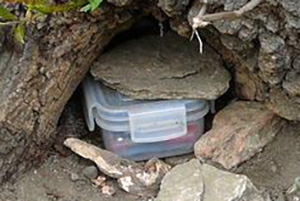
The rubber or plastic toppers on Tupperware are easily penetrated by critters. Any rodent can chew through the tops of the container.
If you do have items stored in Tupperware, be sure the items inside are double wrapped, especially if the items are food.
Then, wrap the entire Tupperware in moisture-resistant bags. Finally, place the wrapped and sealed Tupperware inside your sealed cache.
6. Plastic Containers
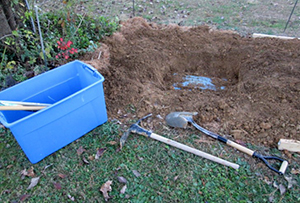 Many casual readers may think plastic containers are great for burial because they are water-tight. However, plastic containers are to be avoided when creating an underground cache. They are not temperature-proof, critters can easily eat away at the material, and they can crack/warp under pressure.
Many casual readers may think plastic containers are great for burial because they are water-tight. However, plastic containers are to be avoided when creating an underground cache. They are not temperature-proof, critters can easily eat away at the material, and they can crack/warp under pressure.
Many preppers use plastic and have no issues with it. To each their own, but I think plastic is a little too flimsy.
This is especially true if you plan on storing food in your plastic container food cache. Save the more durable containers for your food storage, such as steel drums or old metal toolboxes.
7. Perishable Food
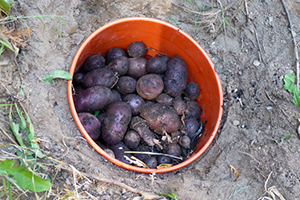 You may have seen that storing root vegetables in the winter ground is okay, but this is not a long-term food storage option.
You may have seen that storing root vegetables in the winter ground is okay, but this is not a long-term food storage option.
Perishable foods should never be kept for long-term prepper storage, especially underground.
Keep in mind that you likely will not be babysitting your underground cache, so it must be as element-proof as humanly possible. Animals will always smell fresh food and will stop at nothing to get to it.
Related: How To Preserve Your Vegetables Using Sand
8. Wood Containers
Any biodegradable material will completely disintegrate into the soil within a few years. Wood is biodegradable, even if it is treated. Wood boxes, palates, or chests are not to be buried, no matter what the inside contents include.
Remember, you are likely not regularly checking on these items and you are certainly not digging them up often. Wood degrading for a few years in the soil will ruin your hard work and spoil your contents.
Final Words
Here, we have examined a few of the items you should never store underground. If you chose to create an underground cache, you must be 100% confident that the contents will still be there in 1, 5, or 10 years.
You never know when an emergency will strike, but you want to be ready at any time. Storing survivalist items underground can help you and your loved ones survive any impending crisis.
You may also like:
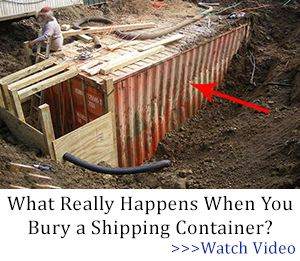 13 On-Screen Survival Lessons that Will Get You Killed
13 On-Screen Survival Lessons that Will Get You Killed
This Hidden Survival Garden Will Keep You Well Fed When SHTF (Video)

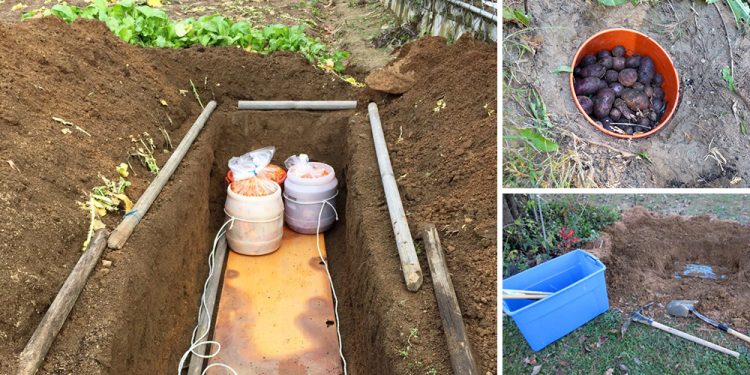













Ah, The love of hiding things that no one knows about. It’s the part that is the most exhilarating.
I bet that we all have hidden a lot of things that we probably for got about some time in our life.
I sure have. But the worst part is that when you do remember where you hide something and then later you find it, maybe years down the road. If you do find it, it is in such bad condition or it’s rotten or it’s been ate thru by some animal or the bugs got in and made a massive Hotel out of it.
Ants are the worst, because they have the means to find some way to enter in to your cache. Then they have a feast on anything that they can chew thru.
I do remember one house I was at I hide a crap load of can goods in between the walls under the stair case. Then we moved and I forgot to get them, so I laugh and thought that one day some one would find them and think, what was they thinking, putting food in between the walls. lol
But, it can be done.
We have seen on tv, some one finds a hoard of gold or silver or even a body.
If you take the time to properly seal what ever it is that you intend to hide, it can last a life time in the ground.
It will be funny to see the smile on some ones face to dig up something and open it up and find an AK47 and 1000 rounds of ammo and food and maybe gold or silver or some water. “If done right.”
Happy hiding…
PS: yes, I know that water is not a good thing to put in to your cache. BUT today we have the technology to keep water in a container and it my or my not destroy what it is that you hide.
I did just see where I missed it, but the biodegradable container.
Should have been a NON, biodegradable – proof container.
That’s okay, we have your back Tracy…
Loved the article. It’s a good one for all of us, to use in these times.
Thank you…
For years on the mountain here I hid coffee cans of food and survival items here and there. Only lost one. Nothing major. I collected up most of them when I knew that was no longer an option because of age. I gave a grandson a make to some. Hes found those and moved a one, kept some in place.
A big cashe is an entirely different story. Im considering something not too deep and nearer home. Maybe under an old vehicle.
Interesting article. Thanks.
Putting moth balls in the ground is just asking for the ground to be poisoned by their chemicals, and by the way they don’t deter snakes either
Very true. You will poison the ground and no, they really don’t deter snakes.
Just one question. How did you get their little legs apart to get the moth balls? I’ve always had trouble with that part.
One would think there would be no more moths considering how many we’ve neutered.
I have no experience with buried caches but have installed my own sprinkler systems with PVC tubing and Christy’s hot glue, which is a permanent waterproof rubber adhesive for connecting PVC. I was thinking to try the heavy PVC pipe used for sewage or outdoor drainage for caches. This stuff is very thick, is made to be buried underground for decades, is available in various diameters and lengths, and for some sizes you can find matching end caps both threaded and non-threaded you can completely seal with waterproof adhesive like Christy’s hot glue. Be advised when PVC is sealed with Christy’s hot glue you would have to cut the pipe to get it open, the glue is permanent. Has anyone tried this?
Christy’s Red Hot Blue Glue. Powerful stuff.
Also try Henry’s for stuff thats not plastic. Sticks to everything, Repels water, and bugs wont chew it. If you’re gonna put any wood underground, coat it with Henry’s first.
Yes, Storing in the ground is not safe. I know a guy who stored over a million dollars in steel 55 drum barrels. He was sure it was fine. He made so much money that he was hiding it from Uncle Sam. Ha!! Well he went to get some money,& his steel barrels had leaked,& ruined his money. He decided to take it to the bank to get it replaced. Banks obligations was to report money for over 10,000.00. NowPresident Biden wants you to prove every time You spend 600.00. It’s not the Federal Government Business, but they may pass this law by Democrats.
Getting back to the guy who hid over a million dollars in 55 gallon drums that filled with water. He was reported to Federal Government & had to pay heavy taxes,& a big fine. He also was going to serve time in prison fir Income Tax Invasion. It cost him big time. I don’t know what happened on this case.
IT WOULD HAVE BEEN BETTER FOR HIM TO BUY A BIG VAULT LIKE BANKS HAVE,& PUT IT IN HIS BIS COMMERCIAL BUILDINGS ABOVE GROUND,& HAD IT INCASED IN CONCRETE,& STEEL SO IT COULDN’T BE ASSED EASLY!! At least rain, snow, fire & storm’s wouldn’t hurt it. HE LEARNED A COSTLY MISTAKE!!
So, Food the best way is a root cellar,& replenish it yearly, put canned goods in it,& vital things. You could make it water tight,& have ventilation,& even put a generator somewhere to heat,& cool it when the power went off. You just have too research it,& if you got the money, then have the huge storm shelters built for storms, survival,& other stuff. Even store a girlfriend down there for special occasions.
Just ONE girlfriend?
I would want at least a dozen so things wouldn’t get ‘stale’ lol
Some young ones as spares for later on….
About the $600 issue.
Computers will ignore things like house/rent payments, car payments, similar.
What they would be looking for is gun purchases, ammo purchases, survival items, etc.
And of course drug related deposits.
Repository or bank vault storage is not always the best option. First, it can be expensive, and you need to make sure you do not lose the key and account information, since both should be kept separately. Second, as with anything related to real estate, it’s location. Those who used underground repositories and bank vaults at the base of the World Trade Center found this out the hard way.
As some of us become less than able mentally with age or illness, think about how to let someone else know where things are or even what you do have.
I was helping a couple in their 90’s around their house. I came across a few Krugerrands in an odd place so I put them in a safer place but told the owner. They disappeared from that place. After much searching, I found them in the bathroom, in the top drawer, next to the toothbrush – not hidden. There were of no use to the owner so he didn’t care where he put them. I sent them off to his daughter, who did very much know what to do with them.
Any recommendations for storing paper documents to protect from fire/water/animals .Not interested in institutional venues . Thinking more along the lines of burial.
Rodents do not like dryer sheets because of all the toxic chemicals in them. When I parked in a rural place that had been vacant for a while and rodents had been having a good time at, I put dryer sheets in my car engine after rodents had chewed away my fire wall. I also added some poison blocks but I think that the dryer sheets did the best job of keeping them away.
I watched a show on TV where they were burying a time capsule on Oak Island. They used a metal pipe and then welded on metal discs on each end.
I have found that sealing documents with the laminating sheets that seal the edges do well buried. I dug up a large coffee can with 5 documents from birth certificates to lease agreements and they were dry even though the can had leaked from the plastic top.
What would be the best way to store ammo in a cache? Is the government already tracking this or do we have e some time prepare?
the gov is tracking your ammo ?
Andrea: Even old-timey paper cartridges last if oiled or greased before burial. Several caches (not ours) in Penna had weapons and ammo greased, oiled, shrink wrapped in plastic, sealed, and then buried in concrete or house walls, dropped in septic tanks, and so on. So far as I hear, even after years they’re sill in good shape. Decades ago, Apocalypse writers/preppers were advocating doing this, especially with copies of important papers. You already know good plastic when kept from the sun and air never decays. But, warning, bacteria that eat oil products are common. But, who would check a used septic tank or outhouse? After a few years, it would be decayed and probably safe to dig in. niio
Airtight and waterproof. Add an O2 absorber and a moisture absorber for good measure. I would find someplace to cache them that is not underground, unless it’s a little known cave or maybe a ‘root-cellar’. As the ground shifts there is always the possibility a container will crack or break. Don’t store all of it in one place, either.
I think the government ‘is’ tracking ammo purchases when and where they can and has been doing it for awhile. Online ammo purchases, especially, are subject to tracking due to the digital trail left. I always buy off-the-shelf and with cash. It does cost a little more, but I’m not leaving as much of a digital trail to follow.
Underground storage tanks for fuel might have more than one type of metal touching each other. In order to stop the corrosive action between the interaction of those two metals, the connective point is anodized. The dictionary definition is, “a protective oxide film by electrolysis”. That I do not know how to do.
One thing to pay attention to, is that some of those fireproof safes have warnings on them to not store things that might rust, such as guns. Maybe the fireproof safes have moisture in the walls?
They are fireproof, not water proof.
Unless they have some type of gasket to seal them selves shut, water will get in.
DZ mentioned sprinkler pipe and Christy’s hot glue. The ideal material for caching underground is sewer and drain PVC pipe, called SDR, Home Depot type stores might have it in 6″ diameter, Landscape supply companies usually sell over the counter to individuals and you can buy it in 12″ diameter. SDR is cheaper than PVC but just as strong, easier to cut. Cut into 4 foot lengths and sealed with glued on caps it is airtight, waterproof, and won’t crack with ground movement. Add moisture absorber and you have perfect long term storage. You can put threaded fittings on it and use screw caps but over time they will lock on so tight you have to cut it anyway. Christy’s Red Hot Blue Glue is not a glue, it is a solvent and melts the surface of the PVC so when you join 2 pieces it forms a weld. Clean the pipe well, coat the joint completely with PVC
solvent, then completely coat with glue and join the pieces together, this will make an airtight, watertight, permanent seal. Good idea to have a rubber mallet at hand so you can bang the cap all the way down. Store rice, guns, ammo, a million in cash and a bottle of Johnny Walker Blue for decades.
Should have said pvc primer instead of solvent, the primer cleans and dries the pipe surface, it is mildly solvent and prepares the surface for the blue glue. Another excellent pipe glue is called Turf Tite, some stores carry one and not the other. Don’t buy Oatey brand, an inferior product.
Well JH I guess you just solved the problem. The author should take note! I would only add that if you’re going to store documents, it’s best that they are acid free. Paper only lasts 100 years.
22 years of being a mechanical contractor I’ve never had a problem with Oatey, why is it inferior ?
Judge, I did not know the heavy sewage and conduit pipe is called SDR, I have not been to the plumbing supply outlets yet, but it’s specifically made to be waterproof and buried underground for long term, have you used it for a buried cache? if so, how long was it buried before you checked on the condition?
When I designed and installed my sprinkler systems, after cleaning and smoothing the PVC pipe ends, then dry fitting everything together BEFORE I glued anything, I used the Chrity’s purple primer first, then after it dried I used the Christy’s hot glue which is blue and needs to be seated very fast before it sets, and have never had any leaks or disconnects, good product. I’ll check at the plumbing supply for the correct adhesive to use for the SDR sewage/drainage conduit pipe connections.
The Christy products are ideal for SDR. The only time I’ve seen it fail is when 90 degree joints are not properly glued and there is enough soil movement to open the joint. It is not affected by soil ph or soil contaminated by petroleum products and most other corrosives. Although I’ve done a fair amount of drainage work over the years I never saw its usefulness for caching until I read it in some Prepper novel. Hint: cut it with a circular saw using a combination blade, less bad language required compared to a pipe saw.
Seeds.
Don’t bury seeds in the ground expecting them to be there when you need them.
Every time I do some jerk comes along and plants a garden right on top of em.
No. I’m not serious.
If you ever read “Lucifer’s Hammer” – one of the best PAW novels around – it has one of the few cache mentions that the prepper novelists have offered up >>> and it’s a good one …
book character Dr. Dan Forrester found a way to be relevant in the post SHTF world after his astrophysics life no longer mattered >>> he buried his home library of technical and prime literature in his abandoned septic tank located on a hill in his backyard – wrapped up Volume 2 of “The Way Things Work” for his carry proof of his buried treasure trove of knowledge …
never read it or need a reminder?? – Part 2/The Hammer and the chapter Hot Fudge Tuesdae: Three
I would like to find the “The Way Things Work” that you reference. I find the same title a few times but they all seem to be single volumes. Do you have a author, publisher, copyright or any thing I can use to find the correct tome?
Further, would you have a recommendation if you were writing the same story for today?
It used to be a series that started as a TV show on BBC. Then they published. Now, this is the best I can do, sorry. https://www.thriftbooks.com/ and put in the browser How things work.
What is PAW an acronym for?
Spike, I searched for “what is acronym PAW?”, and it came up with multiple things:
PAW – Definition by AcronymFinder
https://www.acronymfinder.com/PAW.html
PAW: Partnership for Action Against Wildlife Crime (UK) PAW: Physics Analysis Workstation: PAW: Petroleum Association of Wyoming: PAW: Prodigious Accumulators of Wealth: PAW: Performance Automotive Warehouse: PAW: Profile Available Water (soil capacity) PAW: Passive Attack Weapon: PAW: PDA Animated Weather: PAW: Personal Area Wireless: PAW: Post Acute Withdrawal: PAW
How about Post Apocalyptic World…
Yea I was thinking the same.
do not store anything underground. anything you put into the ground will sweat after a short while. been their done that, but by all means try it first with something that you don’t want to lose like some blank printer paper for 6 months or a year before you commit. their are many other options above ground if you look, and make your storage look uninviting or useless. an old bucket in the corner of an old barn with horse crap on top of it.
you are only limited by your imagination.
I’ll dig a hole and cover it with that horse crap. Future compost for the garden.
I’ll dig a hole and cover it with that horse crap. Future compost for the garden. Nothing much can sweat in the southern Arizona desert.
Mike, erk: We got three crops off the mesquite this year. First was bad because of no rain. Next was great, but had mold issues from the humidity. Last one was crap. niio
Mariokart better than Chrono Trigger? No. Especially when you take into account that it hasn’t aged very well. Mario games are often overrated just because it’s Mario.
Also, Zelda is great but a bit overrated. It’s not the best on the system. Doesn’t deserve to be #1 on so many lists.
I think Super Metroid is probably #1.
We’re stocked on board games, playing cards, and so on. A huge mess of good books. Tapes, records, and DVDs. Much is on an older computer that was ‘retired’ after being rebuilt as well as hard copies. niio